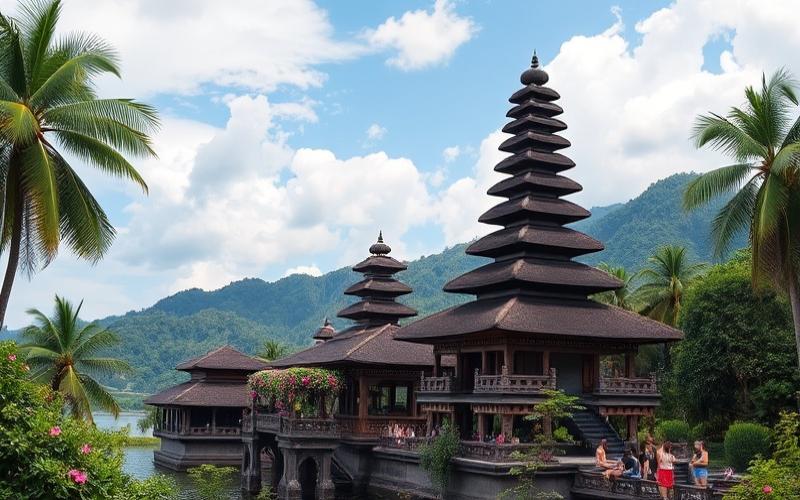
 Published on and written by Cyril Jarnias
Published on and written by Cyril Jarnias
Bali, the jewel of the Indonesian archipelago, has long attracted tourists from around the world with its pristine sandy beaches, rich culture, and breathtaking landscapes. But beyond its tourist appeal, the island has become a true gold rush for real estate investors, particularly French investors seeking diversification and attractive returns. In this article, we will dive into the heart of the Balinese real estate market, compare prices between the island’s main towns, and explore future development prospects.
The Balinese Real Estate Market: Fertile Ground for Investors
Bali’s real estate market has experienced sustained growth for several years, driven by the constant influx of tourists and expatriates drawn to the island lifestyle. Housing prices in Bali start at 1,200 euros per square meter and can reach 3,000 euros in upscale neighborhoods. This price range, significantly lower than many popular European destinations, offers interesting opportunities for foreign investors.
Bali’s appeal for real estate investors is based on several key factors:
- A consistently developing market
- Strong rental demand, particularly for short-term rentals
- Rental yields that can reach 12% per year
- Annual real estate price growth of 10 to 15%
- An exceptional living environment attracting an international clientele
However, it’s important to note that real estate investment in Bali involves certain particularities. Foreigners cannot directly own land but must use long-term lease systems (Leasehold). This legal specificity doesn’t prevent foreign investors from profiting from the Balinese market, provided they thoroughly research acquisition procedures.
Good to Know:
The Balinese real estate market offers attractive opportunities for foreign investors, with competitive prices and high yields. However, it’s crucial to fully understand local legal specifics before getting started.
Focus on Property Prices in Bali’s Main Towns
The Balinese real estate market shows significant disparities between different regions of the island. Here’s an overview of prices in the main towns and tourist areas:
Seminyak: Luxury at a Premium
Seminyak, an upscale beach resort in southern Bali, is renowned for its pristine beaches, gourmet restaurants, and designer boutiques. Property prices here are among the highest on the island, ranging between 2,500 and 3,500 euros per square meter. Luxury villas with private pools are particularly sought after in this area, with prices exceeding 1 million euros for the most exclusive properties.
Canggu: The New Investor Hotspot
Canggu, once a fishing village, has transformed in just a few years into a trendy destination attracting surfers, digital nomads, and savvy investors. Property prices have seen a sharp increase in recent years but remain lower than Seminyak, averaging 1,800 to 2,500 euros per square meter. Modern villas and residential complexes are flourishing here, offering excellent rental profitability potential.
Ubud: Real Estate at the Heart of Balinese Culture
Ubud, Bali’s cultural and artistic center, appeals to nature and spirituality enthusiasts. The real estate market here is dynamic, with prices varying between 1,500 and 2,200 euros per square meter. Traditional Balinese properties coexist with contemporary villas, often nestled amidst lush rice fields. Investment in this region particularly attracts those seeking stable rental yields, thanks to consistent tourist demand.
Sanur: The Charm of Old Bali
Sanur, a calmer beach resort than its southern neighbors, attracts families and retirees. Property prices here are more moderate, ranging between 1,200 and 1,800 euros per square meter. This area offers a good compromise between quality of life and investment potential, with properties often more spacious than in more touristy areas.
Denpasar: The Multifaceted Capital
Denpasar, Bali’s administrative capital, presents a more diversified real estate market. Prices vary considerably by neighborhood, ranging from 800 to 1,500 euros per square meter. While the city center mainly attracts local clientele, peripheral areas like Renon or Sanur offer interesting opportunities for foreign investors, with long-term appreciation potential.
Good to Know:
Property prices in Bali vary considerably by region, ranging from 800 to 3,500 euros per square meter. The most sought-after areas like Seminyak and Canggu show the highest prices, while more affordable opportunities exist in regions like Sanur or certain Denpasar neighborhoods.
Development Outlook: Toward Continued Growth in the Balinese Market
The Balinese real estate market has experienced remarkable growth in recent years, and future prospects remain positive. Several factors suggest favorable price evolution in the coming years:
Constantly Increasing Tourist Demand
Bali welcomes an average of 30 million visitors annually, a number expected to continue growing in the coming years. This tourist influx supports short-term rental demand and stimulates real estate investment. Experts predict annual tourist number growth of approximately 20%, which should translate to upward pressure on property prices, particularly in popular tourist areas.
Developing Infrastructure
The Indonesian government is heavily investing in Bali’s infrastructure development. The construction of new airports, road network improvements, and creation of special economic zones should enhance the island’s attractiveness for investors. These large-scale projects are likely to cause increased property prices in areas benefiting from these improvements, with annual growth rates potentially reaching 10 to 15%.
An Increasingly Mature Market
The Balinese real estate market is gaining maturity, with the arrival of international players and development of large-scale real estate projects. This sector professionalization should help stabilize prices and offer better guarantees for investors. Analysts predict sustained price growth of around 5 to 8% per year in the most established areas, while developing regions might experience more significant increases.
Growing Appeal for International Investors
Bali is attracting more and more international investors, drawn by attractive yields and exceptional living environment. This trend should continue, supporting demand and property prices. Experts anticipate increases in luxury property values of around 7 to 10% per year in the most sought-after areas like Seminyak and Canggu.
The Impact of Remote Work
The growing trend of remote work could also positively impact Bali’s real estate market. More professionals are choosing to settle in Bali to enjoy a pleasant living environment while working remotely. This new demand could stimulate the long-term rental and secondary residence purchase markets, with estimated growth between 3 and 5% per year for this specific segment.
Good to Know:
The development outlook for Bali’s real estate market is generally positive, with forecasted annual price growth ranging from 5 to 15% depending on areas and property types. Key growth factors include increased tourism, infrastructure development, and growing appeal for international investors.
Tips for Investing Wisely in Bali
To get the most out of the Balinese real estate market, here are some tips to keep in mind:
Choose the Right Location
Location is crucial to ensure your investment’s profitability. Tourist areas like Seminyak, Canggu, and Ubud offer the best rental yield potential, with rates reaching up to 12% per year. However, purchase prices are also higher here. Investors seeking more affordable opportunities can look toward developing areas like Tabanan or certain parts of Denpasar, which offer good long-term appreciation potential.
Understand Legal Specifics
It’s essential to fully understand the legal framework of real estate investment in Bali. Foreigners cannot directly own land but can use long-term lease systems (Leasehold) or create an Indonesian company (PT PMA) to acquire properties. It’s highly recommended to consult a specialized lawyer to navigate these legal complexities and secure your investment.
Diversify Your Portfolio
To optimize your investment, consider diversifying your real estate portfolio in Bali. You could combine purchasing a luxury villa in Seminyak for seasonal rental with acquiring an apartment in Denpasar for long-term rental. This strategy will allow you to benefit from both high rental yields and long-term appreciation potential.
Anticipate Additional Costs
Don’t forget to account for additional costs related to real estate investment in Bali. Acquisition fees can represent approximately 10% of the purchase price, including taxes and notary fees. Additionally, budget for maintenance and property management, especially if you opt for seasonal rental.
Stay Informed About Market Developments
The Balinese real estate market evolves rapidly. Stay informed about trends, new development projects, and regulatory changes that could affect your investment. Follow specialized publications and don’t hesitate to consult local experts to benefit from the best opportunities.
Good to Know:
Investing wisely in Bali requires a good understanding of the local market, legal specifics, and long-term trends. A diversified approach, combined with thorough due diligence, can help you get the most out of this dynamic and promising market.
Conclusion: Bali, a Promising Real Estate Market for Savvy Investors
The Balinese real estate market offers attractive opportunities for international investors seeking high yields and exceptional living environment. With prices ranging from 800 to 3,500 euros per square meter depending on regions, and annual growth prospects of 5 to 15%, Bali positions itself as a prime destination for real estate diversification.
Tourist areas like Seminyak, Canggu, and Ubud continue to attract investors with rental yields reaching up to 12% per year, while developing regions offer long-term appreciation opportunities. Continued tourism growth, infrastructure development, and increasing appeal for international investors suggest a promising future for the island’s real estate market.
However, investing in Bali requires a good understanding of local specifics, both legally and culturally. It’s crucial to research thoroughly, diversify your portfolio, and stay informed about market developments to maximize your investment’s success chances.
Ultimately, for those ready to take the leap and explore opportunities beyond traditional borders, Bali represents a high-potential real estate destination, combining attractive returns and exceptional quality of life.
Disclaimer: The information provided on this website is for informational purposes only and does not constitute financial, legal, or professional advice. We encourage you to consult qualified experts before making any investment, real estate, or expatriation decisions. Although we strive to maintain up-to-date and accurate information, we do not guarantee the completeness, accuracy, or timeliness of the proposed content. As investment and expatriation involve risks, we disclaim any liability for potential losses or damages arising from the use of this site. Your use of this site confirms your acceptance of these terms and your understanding of the associated risks.















































